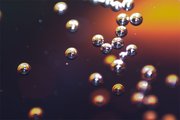Carbonation
|
|

Carbonation occurs when carbon dioxide is dissolved in water or an aqueous solution. This process is generally represented by the following reaction, where water and gaseous carbon dioxide react to form a dilute solution of carbonic acid.
- H2O + CO2 ↔ H2CO3
This process yields the "fizz" to carbonated water, the head to beer, and the cork pop and bubbles to champagne and sparkling wine. Carbonation is used to improve both the taste and "texture" of the carbonated consumable. Carbonation is sometimes used for reasons other than consumption, to lower the pH (raise the hydrogen ion concentration) of a water solution, for example.
Carbonation can occur as a result of natural process, for instance when yeast ferments dissolved sugars sealed in a pressure-tolerant bottle or keg, or it can be done artificially, by dissolving carbon dioxide under pressure into the liquid. Sometimes, natural carbonation is called conditioning while the term carbonation is used to refer to the artificial process.
In homebrewing, overcarbonation can be dangerous, resulting in gushing, or even exploding bottles in extreme cases. Adding priming sugar or malt extract at bottling time to beer that has had its fermentable sugar content totally consumed is the safest approach to carbonation. Exceeding recommended levels of priming sugar for a given recipe is dangerous, as is using inappropriate bottles or improper capping methods.
